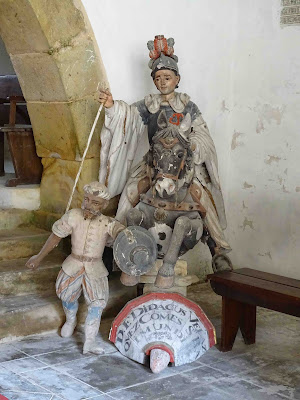La Hoguera de San Juan en Oviedo
Midnight on June 24th is the Hogueras de San Juan (Bonfires of Saint John), which is a really big deal here in Spain. This celebration of John the Baptist’s birthday is held a few days after the summer solstice, just at the time that the shortening of the daylight hours first becomes perceptible, and it clearly has its origin in ancient pagan rituals designed to mark the midsummer sun’s slow retreat into winter.
The most famous celebration of the Hogueras de San Juan in Spain take place in Alicante, where the festival has grown into an over-the-top, multi-day spectacle, highlighted by an artistic competition for the massive, elaborate figural hogueras each neighborhood erects. The bonfire celebrations of Saint John’s Day are equally important in Catalonia, where they have come to be seen as a national holiday.
While our Fogueres de San Xuán (as they are called here in Asturias) are by no means as elaborate as those in Alicante, nor do they have the nationalistic connotations they do in Catalonia, they are charming events nonetheless. And this year’s Hoguera de San Juan in Oviedo was particularly moving.
Overview of Cathedral Square at start of festival.
At the end of the clip, note Toño Velasco waking up from his dream on top of the hoguera.
"Teatro Margen" and Héctor Braga and his band.
Set in the Plaza of the Cathedral, Oviedo’s celebrations began at 10:30 pm with two intertwined events. On a stage erected in front of the plaza’s fountain, the dance group “Teatro Margen” interpreted the emigrant experience that is so central in Asturian history, dancing to traditional Asturian folksongs rendered in a country-western style by Héctor Braga and his band, who played on the bandstand behind the stage. At the same time, at the hoguera in the middle of the plaza, the Oviedo artist Toño Velasco provided a performance piece based on Goya’s famous 1799 print El sueño de la razón produce monstruos (The sleep of reason produces monsters); Velasco began his performance “asleep” on top of the bonfire, which had been draped with white paper, then “awaking” to paint the monsters he had seen in his dreams.
"Teatro Margen" and Héctor Braga and his band.
Note that Braga is playing a hurdy gurdy, the drone-strings of which are reminiscent of bagpipes
"Teatro Margen" and Héctor Braga and his band.
The versatile Braga plays a harp here.
Toño Velasco painting his "monsters".
Toño Velasco painting his "monsters".
A particular cute part of the “Teatro Margen” performance was the cross-dressing flamenco dance that was interrupted by a vice policeman.
Mercáu Astur” dance of the ayalgas.
A half-hour before midnight, the Asturian folklore group “Mercáu Astur” took the stage for a magical evocation of the spirits of earth, air, water, and fire. The ritual featured the Asturian mythological creatures the trasgu, the busogu, and the ayalgas and culminated with the dragon—el cuélebre—which, with sparkles flashing, wound its way through the crowd to set the bonfire ablaze.
“Mercáu Astur” dance of the ayalgas.
“Mercáu Astur” dance of the trasgu.
“Mercáu Astur” dance of the busogu.
“Mercáu Astur” dance of el cuélebre.
After the hoguera burned down and the burning embers abated, the night concluded with a dance around the dying bonfire. A good night.





Comentarios
Publicar un comentario